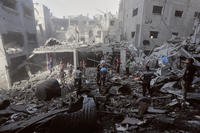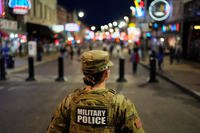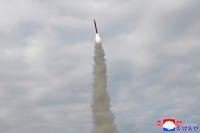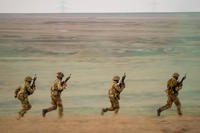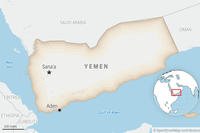The Biden administration is hoping to fly thousands of Afghan refugees, allies and American civilians out of Afghanistan daily before the end of the month. Yet the Defense Department has no plan to get people trapped in Kabul behind a gauntlet of Taliban checkpoints to the airport. Instead, it is zeroing in on military efforts to secure the airfield itself and not go into the city, which has been thrust into chaos.
The Taliban control all of Kabul, the capital of Afghanistan, where Hamid Karzai International Airport is located. It is the only functional airport in the country, and U.S. and allied troops have dug in to secure evacuations of what the Pentagon hopes to be 4,500 to 9,000 people per day.
In his first remarks since the Taliban laid claim to Kabul, Defense Secretary Lloyd Austin said he could not help open a path to the airport using the military. “I do not have the capability to go out and extend operations currently into Kabul,” he told reporters Wednesday at a press conference with chairman of the Joint Chiefs of Staff Gen. Mark Milley.
“We will stay focused on securing the airfield,” he said. “We cannot afford to either not defend that airfield or not have an airfield that’s secure, where we have hundreds or thousands of civilians that can access the airfield at will and put our forces at risk.”
Austin suggested that forces on the ground could take military action, but did not go into detail as to what that would entail or what limits might be imposed on their combat. He emphasized that those forces are not equipped to go into the city and evacuate large groups of people ahead of the administration's announced deadline of Aug. 31 to withdraw from the city.
Pushing into Kabul could set up a fight for territory between the U.S. and the Taliban, who have otherwise ceded the airport for now and appear to be waiting out American forces.
Read Next: Air Force Reviewing Fatal Incident at Kabul Airport Where Crowd Rushed a C-17
Suhail Shahenn, a Taliban spokesman, told NPR that American troops and civilians will not be attacked. But U.S. forces are expected to complete their withdrawal by Sept. 11, and any further continuation of the mission could be considered an "occupation," he added.
In an interview with ABC anchor George Stephanopoulos, clips of which were released online Wednesday evening, Biden said troops would stay beyond Aug. 31 if necessary to evacuate all Americans – but stopped short of making the same commitment for Afghans.
“We’re going to do everything in our power to get all Americans out, and our allies out,” Biden said.
If the military can increase its evacuations to 5,000 to 7,000 people per day, Biden said, everybody will be out by the end of the month.
Biden differed with Stephanopoulos’ estimate of some 80,000 Afghan allies and their families who need evacuation, and said the administration believes there are more like 50,000 to 65,000.
Biden said he is committed “to get everyone out that, in fact, we can get out and everyone who should come out.”
If not all evacuations are done by Aug. 31, he said, “we’ll determine at the time who’s left.” If any Americans remain behind, Biden said, troops will stay until they are out.
The stalemate at the airport, with the Taliban preventing people from getting in and U.S. forces keeping people out, unfolded as blame for the rapid takeover of Afghanistan by an enemy American troops have fought for two decades was being assigned in Washington.
The Pentagon did not expect the Afghan government to crumble so quickly. The Biden administration projected many scenarios where the Taliban conquered the country, but no officials seem to have foreseen how quickly Afghan security forces would surrender, effectively erasing the U.S. war effort in weeks.
Still, Milley told reporters Wednesday that now is not the time to analyze military and White House failures, delaying a reckoning until some time later. He said troops are in a dangerous faceoff with the Taliban.
"The time frame of a rapid collapse ranged from weeks, months and even years following our departure,” he said. “There was nothing I or anyone else saw that indicated a collapse of this army and government in 11 days."
"Right now, we have to focus on this mission because we have soldiers at risk and we also have American civilians and Afghans who supported us for 20 years at risk,” he added. “This is personal."
As of Wednesday afternoon, the U.S. has amassed a force of 4,500 troops, all at the Kabul airport. That includes two Marine battalions, one battalion from the Minnesota Army National Guard, three from the 82nd Airborne Division, and one from the 10th Mountain Division.
In total, Milley said there are some 20 companies on the ground ready to fight. On top of ground forces, he said there are "multiple squadrons" of combat aircraft, including F-18s, AC-130 gunships, B-52 Stratofortress bombers, F-16 Fighting Falcons and drones.
President Joe Biden has authorized as many as 6,000 ground forces. Pentagon Press Secretary John Kirby said earlier on Wednesday that a few hundred extra troops are expected to arrive within the next 24 hours.
Foreign forces, including Turkish, French and British troops, are backing up the U.S. in securing the airfield, which both Milley and Austin described as the top security priority in the country. Without the airfield, there can be no evacuations, and American civilians and Afghan allies likely would be trapped in what has become a nation ruled by the Taliban.
Roughly 600 Afghan troops, who may be the last remnants of that military who refused to surrender to the Taliban, also are holding their ground at the airfield. Kirby did not offer any clear plan to get those soldiers into the U.S. when asked by reporters.
Milley noted that a "variety of special operations units" are on the ground, to include special forces from allied counties such as the United Kingdom. Special operations forces are rarely deployed just to secure a perimeter, although any missions into Kabul could upend the status quo that has created some level of calm in the city.
Zabihullah Mujahid, a Taliban spokesperson, said at a press conference Monday that the Afghans who fought against the Taliban or aligned with the U.S. and its coalition partners will be forgiven. Yet the city is laced with Taliban checkpoints, and there are reports of Afghans being beaten as they attempt to make their way to the airport.
On Capitol Hill, there's widespread bipartisan fury over what is almost universally seen as an abysmal exit from Afghanistan as most U.S. troops were removed from the country before civilian evacuations could take place.
"I am disappointed that the Biden administration clearly did not accurately assess the implications of a rapid U.S. withdrawal,” Sen. Bob Menendez, D-N.J., said in a statement Tuesday. “We are now witnessing the horrifying results of many years of policy and intelligence failures.”
Menendez placed some of the blame with President Donald Trump's "inadequate agreement" with the Taliban, but said the current quagmire is the result of two decades of bipartisan failure. He added that he is launching a congressional investigation into the failed exit. The Trump administration had reached a deal including a ceasefire with the Taliban that stipulated that U.S. forces pull out of the country by May 1 and release prisoners of war in exchange for the Taliban not allowing Afghanistan to be used as a hub for terrorism, a deadline Biden initially extended to Sept. 11 before scaling back to the end of August.
"The committee will seek a full accounting for these shortcomings as well as assess why the Afghan National Defense and Security Forces collapsed so quickly," Menendez said. "Congress was told repeatedly that the Afghan Defense and Security Forces were up to the task, that it had the troops, equipment and willingness to fight. To see this army dissolve so quickly after billions of dollars in U.S. support is astounding."
Scorn from Democrats potentially sets up Biden's first serious bout with his own party, which has previously been mostly supportive of his agenda.
Sen. Jack Reed, D-R.I., chair of the Armed Services Committee, said that committee will also hold hearings on "what went wrong in Afghanistan and lessons learned to avoid repeating those mistakes."
"There are no easy answers to how we got here," Reed said in a statement Tuesday. "I would argue that several factors... [including] a disastrous pivot to a war of choice in Iraq; a failure to have an effective policy to deal with a duplicitous Pakistan; a failure of mission creep from counter-terrorism; and a lack of ability to build an effective Afghan government and security forces."
-- Steve Beynon can be reached at Steve.Beynon@military.com. Follow him on Twitter @StevenBeynon.
-- Stephen Losey can be reached at stephen.losey@military.com. Follow him on Twitter @StephenLosey.
Related: 'We've Abandoned the People Who Helped Us': Vets Grapple with Emotions over the Fall of Afghanistan



